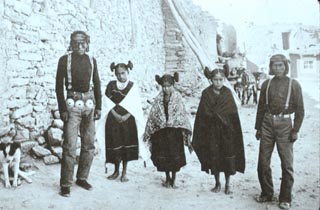Southwest - Pueblo Study Guide
 |
| Hopi |
The materials on this page are intended for use by students enrolled in
ANTH 329 North American Indians. This page and its references are periodically up-dated.
Reading Assignments
Gill 1982: 16-20, 45-50, 59-62, 71-78, 91-92, 133-138 and 142-150
Oswalt and Neely 1999:292-327
Suggested Video
Hopi: Songs from the Fourth World.
Overview
The primary focus of this section will be on the Hopi, a Pueblo people of Arizona and
the Southwest culture area. Additional references will also be made to the Acoma and Zuni
Pueblo peoples. While used to refer to themselves as a people, the word "hopi"
also holds one of the keys to understanding Hopi culture. It entails the idealized notions
of "cooperation, self-effacing, and non-aggression."
The Southwest culture area covers the southern areas of Utah and Colorado in the north,
the entirety of Arizona and New Mexico, and the northern area of Mexico in the south.
The Pueblo tribes, such as the Hopi, Zuni and Acoma, live in rather densely-populated,
sedentary villages, cultivating among other crops, maize and beans. They are known for
their religious societies, such as the Kachinas, and their ceremonial chambers, kivas.
The focus of the masked dances is on the fertility of their crops. Hopi culture can be
characterized by its resiliency and continuity through time, clinging to traditional
cultural expressions in the face of assimilation forces brought on by the Spanish and
later Anglo societies.
Key Concepts and Terms
- "hopi" = good, cooperative, non-aggressive, guardian
of life, bow to collective responsibilities
- hiksi – "breath-body"
- kivas – "world below," ceremonial chambers
- sipapu – "navel" and "path way" to underworld
- páho – prayer offerings
- Katcinas – Gods and Deceased who emerge into upper world from lower
world
- Masau’u – God of Death and Fertility
- Soyoko – Monster Katcinas
- Snake and Antelope Ceremony
- World View – 1. inseparable continuity of and reciprocal exchange between
life and death, body and spirit, earth and underworld – static duality (not
temporal progressive ), and 2. membership in collective dance and ritual
associations of the dead, e.g., Katcinas and Snake Societies, which seek
community fertility (not individualized and visionary-based)
Self-Study Guide Questions
- What does it mean to be hopi and to be kahopi?
- Describe in your own words the central religious concepts of the Hopi. Discuss how those concepts are expressed in the primary Hopi ceremonies, especially those rituals associated with maize and initiation, the activities of the Kachinas, and the character of Maasaw.
- What are the main purposes of the Soyal and Snake Ceremonies? Describe the Hopi
Snake-Antelope Ceremony and what are its functions?
- What are "kachina dolls," and how are they used?
- Who are the "Bahanas?"
- Discuss how the Hopi understand pregnancy and the birth of "twins," and the
process of birth. What are the associated activities and roles of mothers and fathers
before and immediately after birth?
- Discuss the key issues and events that led up to and the short-term and long-term
consequences of the 1906 "rupture at Oraibi?"
- Discuss the Zuni origin account and how it relates to such cultural expressions as village organization, clan structure and the calendar.
Return to Top
You are currently viewing
http://www.uidaho.edu/~rfrey/329swpueblostudy.htm
To return to Frey's Home Page
To return to the Department of Sociology,
Anthropology and Justice Studies
To return to the University of Idaho Home Page
Page manager:rfrey@uidaho.edu


